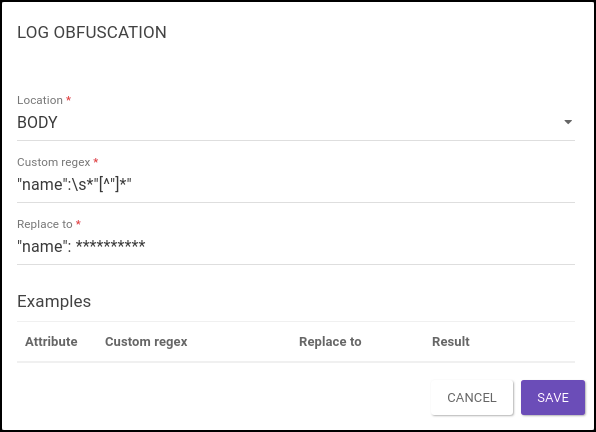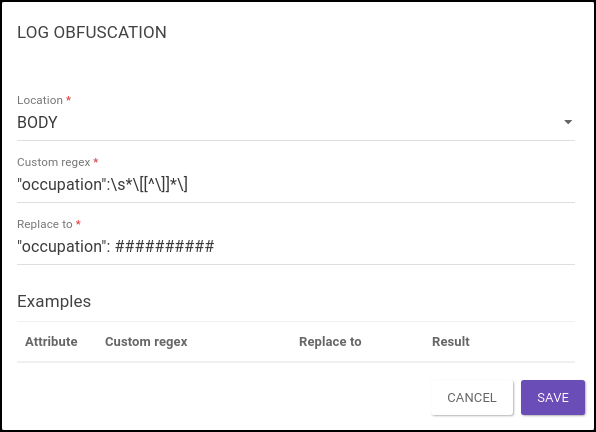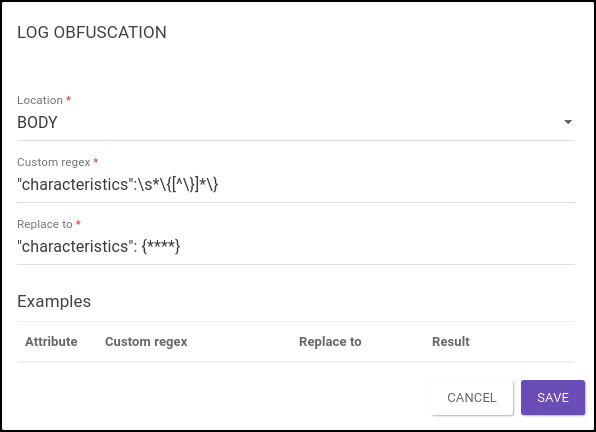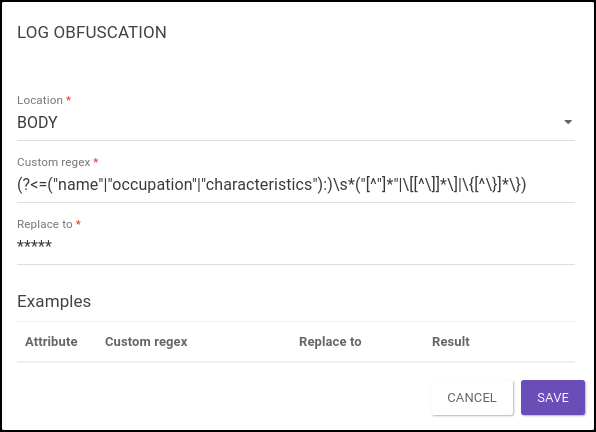Log Obfuscation
This interceptor is used to obfuscate selected data (present in the header or body of the request or response) from Trace logs.
|
To create Trace logs (accessed by clicking the |
Configuring the interceptor
To configure the Log Obfuscation interceptor, you must inform the location of the information to be hidden, a custom regular expression (custom regex) to identify this information, and the symbols to be used in its place (in the field Replace to).

| It is possible to hide multiple pieces of information with a single Log Obfuscation interceptor using a suitable regular expression (as explained here). |
Examples of hiding a single piece of information
Imagine that the body of a request contains the following information:
{
"name": "Jonathan Crane",
"alias": "Scarecrow",
"baseOfOperations": [
"Gotham City",
"Arkham Asylum"
],
"status": {
"alignment": "bad",
"citizenship": "american",
"maritalStatus": "single",
"occupation": [
"anarchist",
"serial killer",
"former psychiatrist",
"university professor"
],
"active": true
},
"characteristics": {
"gender": "male",
"height": 1.83,
"weight": 64,
"eyes": "blue",
"hair": "brown"
}
}You have to create a suitable regular expression to hide a field.
For example, if you want to obfuscate the "name" field, you can add the following settings:

As a result, Trace will show the following log for this request:
{
"name": **********,
"alias": "Scarecrow",
"baseOfOperations": [
"Gotham City",
"Arkham Asylum"
],
"status": {
"alignment": "bad",
"citizenship": "american",
"maritalStatus": "single",
"occupation": [
"anarchist",
"serial killer",
"former psychiatrist",
"university professor"
],
"active": true
},
"characteristics": {
"gender": "male",
"height": 1.83,
"weight": 64,
"eyes": "blue",
"hair": "brown"
}
}To obfuscate the "occupation" field, you can add the following settings:

As a result, Trace will show the following log for this request:
{
"name": "Jonathan Crane",
"alias": "Scarecrow",
"baseOfOperations": [
"Gotham City",
"Arkham Asylum"
],
"status": {
"alignment": "bad",
"citizenship": "american",
"maritalStatus": "single",
"occupation": ##########,
"active": true
},
"characteristics": {
"gender": "male",
"height": 1.83,
"weight": 64,
"eyes": "blue",
"hair": "brown"
}
}Finally, to obfuscate the "characteristics" field, you can add the following settings:

As a result, Trace will show the following log for this request:
{
"name": "Jonathan Crane",
"alias": "Scarecrow",
"baseOfOperations": [
"Gotham City",
"Arkham Asylum"
],
"status": {
"alignment": "bad",
"citizenship": "american",
"maritalStatus": "single",
"occupation": [
"anarchist",
"serial killer",
"former psychiatrist",
"university professor"
],
"active": true
},
"characteristics": {****}
}Combining those three interceptors sequentially, Trace will show the following Log for this request:
{
"name": **********,
"alias": "Scarecrow",
"baseOfOperations": [
"Gotham City",
"Arkham Asylum"
],
"status": {
"alignment": "bad",
"citizenship": "american",
"maritalStatus": "single",
"occupation": ##########,
"active": true
},
"characteristics": {****}
}However, a better way to obfuscate multiple fields is to use a single comprehensive regular expression (see examples below).
Regular expression for multiple information fields
When the data set is part of a JSON, a regular expression for multiple information follows the structure:
(?<=(<keys>):)\s*(<regex_types>)
| The "\s*" of the regular expression is used to ignore any white spaces between key and value. |
Both keys (information) and regex for each type of value must be separated by "|".
The regex for the corresponding value types are:
-
numbers, booleans and null:
[\+\-\w.]+ -
strings:
"[^"]*" -
simple arrays:
\[[^\]]*\] -
simple objects:
\{[^\}]*\}
Examples of hiding multiple pieces of information
Now, imagine that the body of a request contains the following information:
{
"name": "Pamela Lillian Isley",
"alias": "Poison Ivy",
"baseOfOperations": "Gotham City",
"status": {
"alignment": "neutral",
"citizenship": "american",
"maritalStatus": "single",
"occupation": [
"scientist",
"eco-terrorist"
],
"active": true
},
"characteristics": {
"gender": "female",
"height": 1.68,
"weight": 50,
"eyes": "green",
"hair": "red"
}
}For example, to simultaneously hide the "name", "occupation" and "characteristics" fields, you can add the following settings:

As a result, Trace will show the following log for this request:
{
"name":*****,
"alias": "Poison Ivy",
"baseOfOperations": "Gotham City",
"status": {
"alignment": "neutral",
"citizenship": "american",
"maritalStatus": "single",
"occupation":*****,
"active": true
},
"characteristics":*****
}On the other hand, to simultaneously hide the "name", "citizenship", "maritalStatus", "active", "height" and "weight" fields, it’s enough to replace the previous regex with:
(?<=("name"|"citizenship"|"maritalStatus"|"active"|"height"|"weight"):)\s*("[^"]*"|[\+\-\w.]+)
As a result, Trace will show the following log for this request:
{
"name":*****,
"alias": "Poison Ivy",
"baseOfOperations": "Gotham City",
"status": {
"alignment": "neutral",
"citizenship":*****,
"maritalStatus":*****,
"occupation": [
"scientist",
"eco-terrorist"
],
"active":*****
},
"characteristics": {
"gender": "female",
"height":*****,
"weight":*****,
"eyes": "green",
"hair": "red"
}
}| Unlike the case where multiple interceptors were used, the symbols applied to obfuscate the information are necessarily the same. |
Share your suggestions with us!
Click here and then [+ Submit idea]